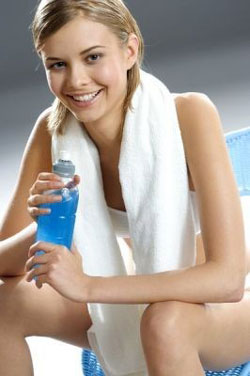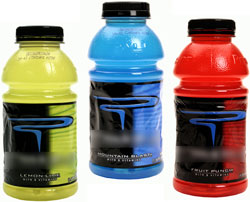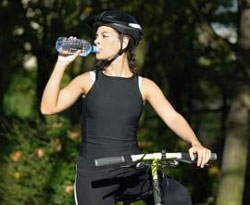|
|
Sports Drink - Good or Bad?
There are three types of sports drink available all of which contain various
levels of fluid, electrolytes and
carbohydrate.
Type
|
Content
|
Isotonic
|
Fluid, electrolytes and 6 to 8%
carbohydrate
|
Hypotonic
|
Fluids, electrolytes and a low level
of carbohydrate
|
Hypertonic
|
High level of carbohydrate
|
 The osmolality of a fluid is a measure of the number of particles in a
solution. In a drink, these particles will comprise of carbohydrate,
electrolytes, sweeteners and preservatives. In blood plasma the particles will
comprise of sodium, proteins and glucose. Blood has an osmolality of 280 to
330mOsm/kg. Drinks with an osmolality of 270 to 330mOsm/kg are said to be in
balance with the body's fluid and are called Isotonic. Hypotonic fluids have
fewer particles than blood and Hypertonic have more particles than blood. The osmolality of a fluid is a measure of the number of particles in a
solution. In a drink, these particles will comprise of carbohydrate,
electrolytes, sweeteners and preservatives. In blood plasma the particles will
comprise of sodium, proteins and glucose. Blood has an osmolality of 280 to
330mOsm/kg. Drinks with an osmolality of 270 to 330mOsm/kg are said to be in
balance with the body's fluid and are called Isotonic. Hypotonic fluids have
fewer particles than blood and Hypertonic have more particles than blood.
Consuming fluids with a low osmolality, e.g. water, results in a fall in the
blood plasma osmolality and reduces the drive to drink well before sufficient
fluid has been consumed to replace losses.
Which is most suitable?
Isotonic - quickly replaces fluids lost by sweating and supplies a
boost of carbohydrate. This drink is the choice for most
athletes - middle and
long distance running or team sports. Glucose is the body's preferred source of
energy therefore it may be appropriate to consume Isotonic drinks where the
carbohydrate source is glucose in a concentration of 6% to 8% - e.g. High Five, SiS Go, Boots Isotonic, Lucozade Sport.
Hypotonic - quickly replaces fluids lost by sweating. Suitable for
athletes who need fluid without the boost of carbohydrate e.g. jockeys and
gymnasts.
Hypertonic - used to supplement daily carbohydrate intake normally
after exercise to top up muscle glycogen stores. In ultra distance events, high
levels of energy are required and Hypertonic drinks can be taken during exercise
to meet the energy requirements. If used during exercise Hypertonic drinks need
to be used in conjunction with Isotonic drinks to replace fluids.
One thing that needs to kept in mind is that the typical sweet-tart taste combination doesn't quench thirst, so you will keep
drinking a sports drink long after water has lost its appeal. An attractive
array of colors and flavors are available. You can get a
carbohydrate boost from
sports drinks, in addition to electrolytes which may be lost from perspiration,
but these drinks tend to offer lower
calories than
juice or soft drinks.
How should I use sports drinks?
Try taking a few gulps in the early stages of your
workout. The goal is to prevent dehydration, not to cure it. Begin with 8 ounces
20 minutes before you start exercising, then drink four to six ounces (half the
amount of liquid in a can of soda) every 15 to 20 minutes; that should be enough
for most types of
exercise.
Evaluating Sports Drink
 Many
"isotonic" sports drinks claim to re-hydrate and boost energy, but any
product containing calories will increase your energy levels. However, the best way to
obtain calories is from the complex carbohydrates found in bread, potatoes,
rice, pasta and cereals. In fact, the least nutritionally satisfactory way is by
eating simple carbohydrates - that is,
sugar. Many sports drinks contain large
quantities of sugar - in some cases, as much as 18 percent. Many
"isotonic" sports drinks claim to re-hydrate and boost energy, but any
product containing calories will increase your energy levels. However, the best way to
obtain calories is from the complex carbohydrates found in bread, potatoes,
rice, pasta and cereals. In fact, the least nutritionally satisfactory way is by
eating simple carbohydrates - that is,
sugar. Many sports drinks contain large
quantities of sugar - in some cases, as much as 18 percent.
Sports drinks also contain caffeine, as well as additives to enhance colour,
flavour, sweetness and stability. Although it may give a sense of instant
energy, caffeine can act as a diuretic and is more likely to dehydrate than
replenish fluids. The additives contribute nothing to performance, although they
may make the product more appealing.
The most efficient rehydration drink is a combination of fruit juice and
water with a pinch of salt. For a quick surge of energy,
snack on
fruit such as a
banana or dried apricots.
Some Sports drink are bad for the teeth and potentially dangerous for
diabetics. They commonly contain citric acid. All acids have an erosive
potential but the method of drinking will influence whether or not those acids
affect the teeth. Sports drinks should be consumed as quickly as possible,
preferably with a straw and not be held or swished around the mouth. Retaining
drinks in the mouth will only increase the risk of erosion. Refrigerated drinks
will have a reduced erosive potential, as the acid dissolution constant is
temperature dependant..
Many ingredients in sports drinks come with a warning of health hazards if
taken in quantity. Although one dose of a suspected carcinogen (such as an
artificial dye) may not harm you, repeated use through ingestion of gallons of a
sports drink may eventually cause symptoms. To learn more about various
additives added in sports drink and their effects,
click here.
The American College of Sports Medicine recently
condemned these drinks and was dismissive of the idea that they are superior to
water.
Want to make your own?
 Isotonic - 200ml of orange squash (concentrated orange), 1 litre of
water and a pinch of salt (1g). Mix all the ingredients together and keep
chilled Isotonic - 200ml of orange squash (concentrated orange), 1 litre of
water and a pinch of salt (1g). Mix all the ingredients together and keep
chilled
Hypotonic - 100ml of orange squash (concentrated orange), 1 litre of
water and a pinch of salt (1g). Mix all the ingredients together and keep
chilled.
Hypertonic - 400ml of orange squash (concentrated orange), 1 litre of
water and a pinch of salt (1g). Mix all the ingredients together and keep
chilled.
Don�t waste your money on sports drinks � the only thing that you will
achieve, will be a compromise on your health and performance.
Related Links
|
|
|
|
|









